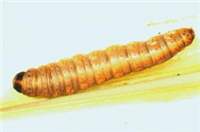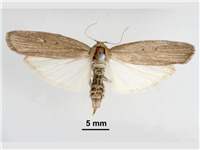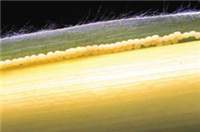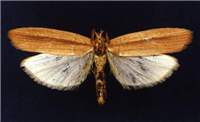Click on images to enlarge

Eldana saccharina adult. ©Stemborer team, icipe

Larva of Eldana saccharina (African sugarcane borer). ©Stemborer team, icipe . Available at www.infonet-biovision.org

Adult of Eldana saccharina (African sugarcane borer). Photo: Ken Walker (CC-BY) http://en.wikipedia.org/wiki/Eldana

Eggs of African sugarcane borer (Eldana saccharina). ©Stemborer team, icipe

Exit hole of African sugarcane borer (Eldana saccharina) ©Stemborer team, icipe

Eldana saccharina adult moth, set specimen. ©David Agassiz (source CABI CPC)
Summary
Indigenous to Africa, the African sugarcane stalkborer is widely distributed in sub-Saharan
Common Names
Sugarcane stalkborer, African sugarcane stemborer, Eldana borer
Synonyms
Eldana conipyga
Taxonomic Position
Phylum: Arthropoda; Class: Hexapoda (Insecta);Order: Lepidoptera;Family: Pyralidae;Subfamily: Gallerinae
Origin and Distribution
Indigenous to Africa, the African sugarcane stalkborer is widely distributed in sub-Saharan Africa including
Description
Eggs
The eggs of the African sugarcane stalkborer are yellow and oval and laid in batches and in maize usually on dry dead maize leaves. They become pink just before emergence.
The African sugarcane stalkborer larvae are light-brown to dark-grey coloured with brown pinacula (hardened – sclerotized – areas that indicate points of muscle attachment), covered with very small dark coloured spots and have a distinct brown prothoracic shield (a plate on the dorsal surface of the thorax). The head is reddish-brown to dark-brown. Larvae may be distinguished from other stemborer larvae by the circular arrangement of crochets (hooks) on the prolegs, pinacula and tubercles (small rounded projections) along the body.
Adults
The adult African sugarcane stalkborer is small with a wingspan of 35 mm. The forewings are pale brown with two dark spots in the centre and elongate with a rounded front edge. The hindwings are whitish with a short fringe and brown longitudinal veins. At rest the wings are folded over the abdomen in such a manner that their outer edges are parallel to each other, and they cover the lighter coloured hind wings which are hidden from view.
Similar Species
Both the adult or larval stages are unlikely to be confused with any other stem borers present in
Life Cycle
Eggs are laid in batches of 50 - 100 eggs in folds of dead leaves, behind the leaf sheath or on dry leaves at the bases of plants or on plant debris on soil. Females may lay 400-600 eggs in their lifetime. Eggs hatch within five-six days.
Young larvae feed externally on the green surface of the plant and later tunnel into the stems where they eat out tunnels within which they pupate.
Larvae can develop in 21 days but development may last up to three months. The larvae do not go into a state of suspended development (diapause ). Adults emerge in 7-14 days after the onset of pupation and only live for a few days.
Pest Destructive Stage
Larva (caterpillar )
Host Range
Sugarcane is the main crop host of the African sugarcane stalkborer but it will also attack maize, sorghum and rice. In the wild its hosts are wild grasses (Poaceae) such as
Host Lifestage Affected
Vegetative growing stage
In Eastern Africa, Eldana saccharina is often only a minor pest on maize but is a major pest on sugarcane. Because the pest attacks plants later in their development, infestations affect grain filling which results in yield losses.
Host Plant Part Affected
Stems
Damage Symptoms
Stem tunnelling and/or breakage; holes in tunnelled stems often with frass hanging from them; cob damage; Reduced grain yield (weight).
Pest Management
Detection methods
African sugarcane stalkborer infestations may be detected by walking through young crops looking for characteristic feeding marks on funnel leaves, the presence of dead hearts and holes in tunnelled stems. Samples of affected stems can then cut open to find caterpillars and pupae.
African sugarcane stalkborers may be detected in older crops and in crop residues by taking random samples of stems to dissect to find caterpillars and pupae.
Cultural practices
Intercropping maize with non-hosts crops like cassava or legumes like cowpea can reduce spotted stemborer damage. Alternatively, maize can be intercropped with a repellent plant such as silver leaf desmodium (Desmodium uncinatum) and a trap plant, such as Napier grass (Pennisetum purpureum), molasses grass (Melinis minutiflora) as a border crop around this intercrop to protect maize from stemborers. The trap plant draws the adult female away from the crop. More eggs are laid on the trap plant than on the crop but the larvae develop poorly or not at all on the trap plant. This practice is known as "push-pull".
Biological control
Biological control by two parasitic wasps, Cotesia flavipes and Xanthopimpla stemmator, that attack the spotted stemborer, has shown good results. Cotesia flavipes locates the stemborers while they are feeding inside the plant stems. The wasp lays about 40 eggs into a stemborer. Upon hatching the larvae of the parasitic wasp feed internally in the stemborer, and then exits and spin cocoons. Xanthopimpla stemmator operates similarly but attacks the pupae. Habitat management practices that conserve these parasitoids and predators like ants and earwigs can help in the control of the spotted stemborer.
Chemical control
Chemical control can be achieved by applications of granules or dusts to the leaf whorl early in crop growth to kill early larval instars. This method has limited effectiveness once the larvae bore into the stem. Neem products (powder from ground neem seeds) are reportedly effective and may be applied to the leaf whorl in a 1:1 mixture with dry clay or sawdust. Pesticides are poisons so it is essential to follow all safety precautions on labels.
Sources of Information and Links
Assefa Y., Conlong D.E. and Mitchell A. (2006). Status of Eldana saccharina (Lepidoptera: Pyralidae), its host plants and natural enemies in Ethiopia. Bulletin of Entomological Research 96, 497 – 504.
Bosque-Pérez, N.A. (1995). Major insect pests of maize in Africa: biology and control. IITA Research Guide 30. Training Program, International Institute of Tropical Agriculture (IITA), Ibadan, Nigeria. 30 p. Second edition.
Girling D.J. (1978). The distribution and biology of Eldana saccharina Walker (Lepidoptera Pyralidae) and its relationship to other stem-borers in Uganda. Bulletin of Entomological Research 68, 471 – 488.
Kfir R., Overholt W.A., Khan Z.R. and Polaszek A. (2002). Biology and management of economically important lepidopteran cereal stem borers in Africa. Annual Review of Entomology, 47: 701-731.
Overholt W.A, Maes K.V.N and Goebel F.R. 2001. Field guide to the stemborer larvae of maize, sorghum and sugarcane in Eastern and Southern Africa. ICIPE Science Press, Nairobi, Kenya.
Polaszek A. (ed.) (1998). African cereal stemborers; economic importance, taxonomy, natural enemies and control. CAB International, Wallingford, Oxon, UK. 530pp.
Editors
Anne M. Akol, Makerere University; Maneno Y. Chidege, Tropical Pesticides Research Institute; Herbert A.L. Talwana, Makerere University; John R. Mauremootoo, BioNET-INTERNATIONAL Secretariat.
Acknowledgments
We recognise the support from the National Museums of Kenya, Tropical Pesticides Research Institute (TPRI) - Tanzania and Makerere University, Uganda. This activity was undertaken as part of the BioNET-EAFRINET UVIMA Project (Taxonomy for Development in East Africa).
Contact
BioNET-EAFRINET Regional Coordinator: [email protected]












